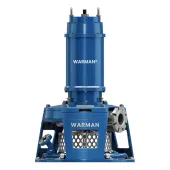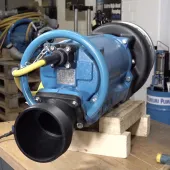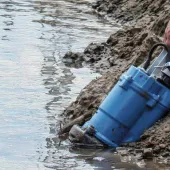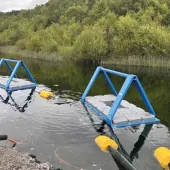The Use of Jet Pumps to Transport Aggregates

First published in the August 2014 issue of Quarry Management as Riding the Jet Stream
Conveying sands and gravels stably and automatically in a pipe using a jet pump
The principle of the jet pump has been known about since Roman times as a method for conveying or transporting solids using water in a pipe, but industrial applications in the UK quarrying industry have only been in operation for the last 40 years or so. So, what is a jet pump and what makes it different from the centrifugal pumps which are commonly used in quarries for a wide range of duties?
A jet pump has no moving parts, consisting of simply a nozzle, receiving pipe and mixing chamber into which the product to be moved is fed. It is powered by a supply of pressurized fluid (usually from a conventional centrifugal pump), which is known as the motive flow. The motive nozzle converts this pressure energy into velocity energy, creating a high-speed jet that induces solids through a shroud or suction duct and into the mixing chamber. The streams combine within the mixing chamber to produce a combined discharge against the head required to drive the pipeline. Fluidization nozzles are used to help mobilize and acquire the material, and the absence of moving parts lends the jet pump to being embedded in the deposit, making it particularly suitable for unsupervised transport and bypassing applications.
The jet pump’s most important attribute, however, is its ability to stabilize the flow in pipelines, which translates into increased reliability and productivity. This is achieved in two ways: first, any increase in pipeline head, perhaps due to a random change in material grading or induced concentration, is countered by an equivalent rise in head developed by the jet pump without the large drop in flow rate that would occur in the case of a centrifugal pump – the system keeps running; then, after this the rate of induction of solids falls, gradually reducing the pipeline head and restoring steady flow. This regulation process is fully automatic and cannot be improved by an automatic control system or operating personnel. Jet pumps can, therefore, be shut down at any time and restarted at will – a valuable feature in transportation or bypassing.
Jet pumps are also routinely used in combination with a surface-mounted centrifugal booster pump to increase the discharge distance. This is referred to as a ‘hybrid’, the purpose of which is to save energy: the overall hydraulic efficiency of a hybrid system is greater than that of a pure jet pump and the reliability far greater than that of a pure centrifugal pump, whether submerged or not.
So, how does this translate into use in quarrying applications? Typical applications are in sand and gravel for transporting excavated product (surface or dredged) from the dig to the processing site. With the impeller of the booster pump being the only moving part, the system is quiet, simple and low maintenance, whilst being completely self-adjusting in operation. The jet pump characteristics can be modified to provide a cavitating action in the case of dirty deposits, such as clay or silt, helping to break up contaminants which can be separated at their destination using conventional methods (screen, flotation etc). This cleaning property is also particularly useful in beach reclamation applications following oil spillage or other contamination.
The secret to effective physical and financial operation of a jet pump system is to ensure that all the requirements and operating conditions are correctly stated at the system design stage. In this way, sufficient capacity can be built in to allow for some variations in feed size or transport distance without compromising overall efficiency, while at the same time ensuring that the system is not over-designed and expensive. The simplicity of the system also means that future upgrades in performance, such as higher tonnages, greater transport distances or increased elevations, can be achieved at reasonable cost when required. Jet pump systems have been running in the UK for nearly four decades now, being upgraded, as required, to maintain performance as dig distances have increased or capacity requirements have changed.
Apart from quarrying applications, the simplicity and effectiveness of the jet pump has found uses in a wide variety of applications. Particular examples include creating offshore trenches for pipes and cables where the jet pump’s lack of moving parts make it a highly effective and reliable tool. In power stations, jet pumps are used for silt removal from settling ponds, and in environmental situations, jet pumps have been used to place gravels for river-bank reinforcement without the need for heavy machinery. Similarly, in contracting, small mobile jet pumping systems have proved very simple and cost-effective in construction projects, removing the need to hire in large equipment whilst allowing fast and accurate placing of materials.
For further information visit: www.jet-pumps.co.uk
- Subscribe to Quarry Management, the monthly journal for the mineral products industry, to read articles before they appear on Agg-Net








